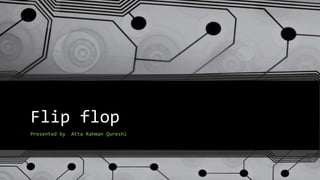
Types of Flip Flops Explained
- 1. Flip flop Presented by Atta Rahman Qureshi
- 2. Content • Introduction to Flip Flop • Types of flip flops 1. R-S flip flop 2. D flip flop 3. J-K flip flop
- 3. Introduction to Flip Flop computers and calculators use Flip-flop for their memory. A combination of number of flip flops will produce some amount of memory. Flip flop is formed using logic gates, which are in turn made of transistors. Flip flop are basic building blocks in the memory of electronic devices. Each flip flop can store one bit of data.
- 4. Types of Flip Flop Based on their operations, flip flops are basically 4 types. They are 1. S-R flip flop 2. D flip flop 3. J-K flip flop 4. T flip flop
- 5. 1. S-R flip flop
- 6. The circuit of a clocked SR flip – flop using NAND gates is shown below.
- 7. SR Flip-Flop S-R Flip Flop The S-R flip-flop is basic flip-flop among all the flip-flops. All the other flip flops are developed after SR-flip-flop. This circuit has two inputs S & R and two outputs Qtt & Qtt’. The operation of SR S-R stands for SET and RESET. This can also be called RS flip-flop. Difference is RS is inverted SR flip- flop. Any flip flop can be build using logic gates. NAND and NOR gates were used as they are universal gates
- 8. Here is the SR flip-flop using NAND gates. And truth table From the above truth table it is clear that SR flip flop will be set or reset for four conditions. For last condition it will be in invalid state. SR Flip-flop will be set when S=1 and R=0, if S=1 and R=1 then previous state is remembered by the flip flop. Flip-flop will be reset when S=0 and R=1, if S=1 and R=1, then it will remember the previous state. But when both the inputs are zeros, SR Flip flop will be in an uncertain state where both Q and Q’ will be same. This is not same allowed
- 9. 2. D flip flop
- 10. D flip flop • In the SR flip flop an uncertain state occurred. This can be avoided by using D flip flop. Here D stands for “Data”. It is constructed from SR flip flop. The two inputs (S &R) of the clocked SR flip flop are connected to an inverter. • It is one of the most widely used flip – flops. It has a clock signal (Clk) as one input and Data (D) as other. • There are two outputs and these outputs are complement to each other. The symbol of D flip – flop is shown below.
- 11. D flip – flop using NAND gates is shown below.
- 12. D flip flop Working D flip flop will work depending on the clock signal. When the clock is low there will be no change in the output of the flip flop i.e. it remembers the previous state. When the clock signal is high and if it receives any data on its data pin, it Changes the state of output. When data is high Q reset to 0,while Q is set to 0 if data is low. A master slave D flip flop can be constructed using D-flip flop.
- 13. 3. J-K flip flop
- 14. J K flip flop JK flip – flop is named after Jack Kilby, an electrical engineer who invented IC. A JK flip – flop is a modification of SR flip – flop. In this the J input is similar to the set input of SR flip – flop and the K input is similar to the reset input of SR flip – flop. The condition J = K = 1 which is not allowed in SR flip – flop (S = R = 1) is interpreted as a toggle command. The JK flip flop has •Two data inputs J and K. •One clock signal input (CLK). •Two outputs Q and Q’.
- 15. The symbol of a JK flip – flop is shown below. And truth table
- 16. The circuit of a JK flip – flop using gates is shown below. It is similar to a modified NAND SR flip – flop.
- 17. Working •When J is low and K is low, then Q returns its previous state value i.e. it holds the current state. •When J is low and K is high, then flip – flop will be in reset state i.e. Q = 0, Q’ =1. •When J is high and K is low then flip – flop will be in set state i.e. Q = 1, Q’ =0. •When J is high and K is high then flip – flop will be in Toggle state or flip state. This means that the output will complement to the previous state value.